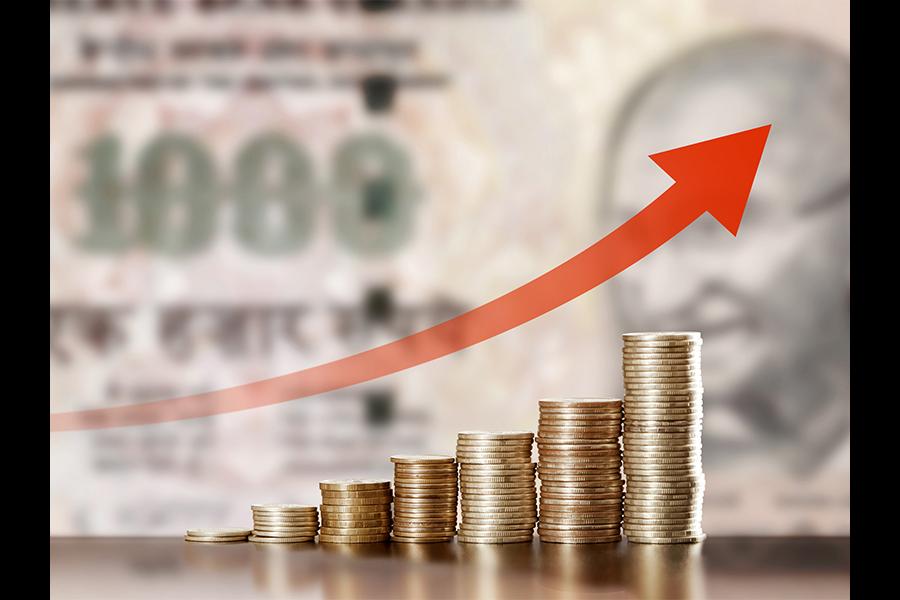Eye on forex: What could guide the Indian Rupee in the near-term?
The optimism surrounding Indian economy and the prudent monetary/fiscal policy should result in India continuing to see a rising share of global capital
Contrary to widespread view of depreciation, Indian Rupee (INR) has appreciated sharply by approximately 5 percent since the beginning of this year on robust foreign inflows and apparent change in RBI’s response towards fx management. INR rally was largely in sync with uptick in global exports and generalized EM basket appreciation against dollar. However, INR outperformed the peer EM basket given India’s benign macro-stability parameters, prudent fiscal and monetary policy, continued thrust on reforms and favourable long term growth outlook.
Trump administration’s currency policy, improvement in global US Dollar (USD) liquidity, global reflation trade, uptick in world trade and stability in Chinese Yuan (CNY) were global tailwinds for stronger INR. Moreover, electoral victory by the ruling BJP in the recent state elections also boosted confidence on long term political stability and ability to push reforms like the Goods and Services Tax (GST), thereby boosting confidence on Indian assets. We believe that the optimism surrounding Indian economy and the prudent monetary/fiscal policy should result in India continuing to see a rising share of global capital.
Change in Reserve Bank of India (RBI) stance: RBI’s comfort and relatively muted intervention amidst sharp appreciation towards 64 levels caught market players by surprise, and was an important reason for the sharp appreciation in currency. We believe that there is a stronger case for central bank intervention in fx market on the face of strong capital flows and we have to see whether the recent laissez faire approach reflects a fundamental shift in RBI’s approach or is just temporary fallout of the current liquidity scenario.
Absent RBI’s anchor, INR is likely to be much more market determined with on an average higher volatility than what markets have got used to over the last 3 years. Decline in RBI’s role in fx market is likely to result in higher volatility in USD-INR and hence the possible range of outcomes is likely to widen.
INR overvaluation is unsustainable: INR is currently at overvalued levels on relative as well as absolute basis which is beginning to negatively impact trade deficit. This sharp appreciation in INR on the back of capital strong inflows without any significant improvement in relative productivity is likely to be detrimental for India’s external balance sheet with exports and current account likely to be impacted negatively. We also note that India continues to run current account deficit and has a large liability position in International Investment Position, which creates long term sustainability issue.
Moreover real exchange appreciation is a form of monetary tightening at a time when domestic demand remains weak, inflation is trending down and credit growth is hovering close to all-time lows.
Strong currency is its best antidote: We note that the change in RBI stance disconnects the link of USD-INR with Real Effective Exchange Rate (REER) based valuations in the short run. However, in the longer run, unduly strong currency sans material change in productivity tends to self-correct through weakening external account. However, this self-correction is generally more volatile with potentially negative impact on the economy.
INR Outlook: Our long term view is for INR to ultimately self-correct, albeit with a lag. However, in the near term USD-INR is likely to be function of continuation of “Trump trade”, FII flows into Indian markets, and geo-political risk factors.
We expect some depreciation in INR from current levels and we see USDINR in the range of 66.0-67.0 by the end of CY2017.
|
USD-INR (end CY2017) |
||
| Scenario | Range | Probability |
| Bull case | 63.80 | 25 |
| Base case | 66.0-67.0 | 60 |
| Bear case | 68.85 | 15 |
Base case: We see USD-INR gradually moving towards 66.0-67.0 range by end-CY17 in our base case (60% probability). Sustained INR appreciation like we saw in 2006-2007 is less probable since current state of Global and Indian economy is nowhere comparable to 2006-2007. We believe that high INR REER shall start negatively impacting current account from 2HCY17. Moreover, unless we see revival in capex cycle, we will be cautious on growth outlook and sustainability of foreign flows. Despite the recent decline in inflation, there is still extant inflation differential which does not bode well for export competitiveness and domestic competition against imports.
In the near-term INR will be guided by foreign flows, President Trump’s ability to fulfil his taxation plans and geo-political risks. Should the geo-political risks abate and FII inflows continue, USD-INR shall come under renewed pressure. However, 63.70 is a strong support and should not give away easily.
Bull Case: Our bull case (25% probability) INR forecast for end-CY17 is 63.70. Bull case scenario factors in healthy growth in world trade, weakness in USD, uptick in India’s investment cycle and smooth implementation of GST. We would also not rule out short-term spike in INR towards 62.80 in blue sky scenario like India ratings upgrade. However, we believe that USDINR is unlikely to sustain below 63.70 unless there is major dollar weakness globally.
Bear Case: Our bear (15% probability) case INR forecast for end-CY15 is 68.85. Bear case is likely to play out should some of the geo-economic risk materializes like spike in protectionist policies and weakness in world trade, currency related tensions, breakdown of Trump trade and renewal of concerns about Chinese economy. El Nino related spike in inflation and political setbacks for Modi government in state elections are domestic risks. Some major geo-political risk event also has the potential to send INR to new lows. We note that with RBI changing its stance, we should be prepared for wider range of USD-INR movements.
1. Macro-stability improving at faster pace for India
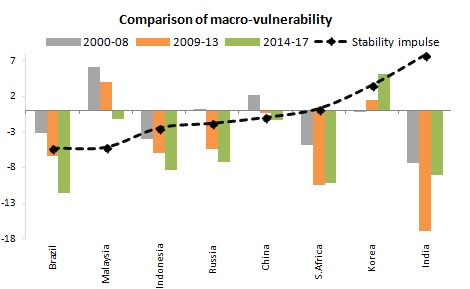 2. EM trade rebounds
2. EM trade rebounds
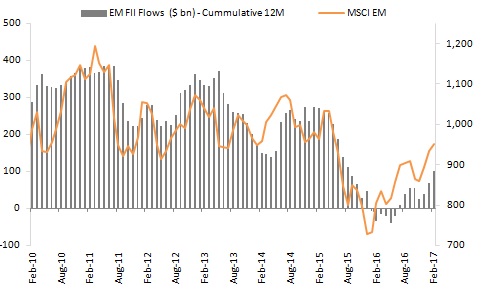 3. FII flows at record level in March/April
3. FII flows at record level in March/April
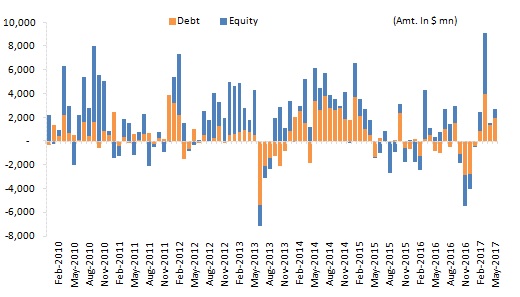 4. Robust trend in FDI flows
4. Robust trend in FDI flows
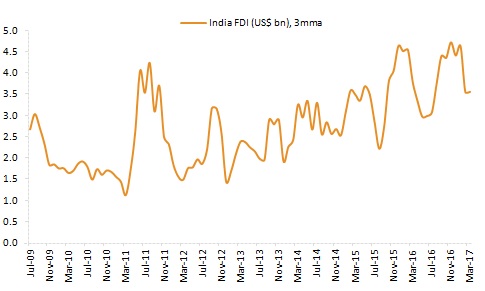 - By Bhupesh Bameta, Head of Research, Edelweiss Forex and Rates
- By Bhupesh Bameta, Head of Research, Edelweiss Forex and Rates
The thoughts and opinions shared here are of the author.
Check out our end of season subscription discounts with a Moneycontrol pro subscription absolutely free. Use code EOSO2021. Click here for details.

